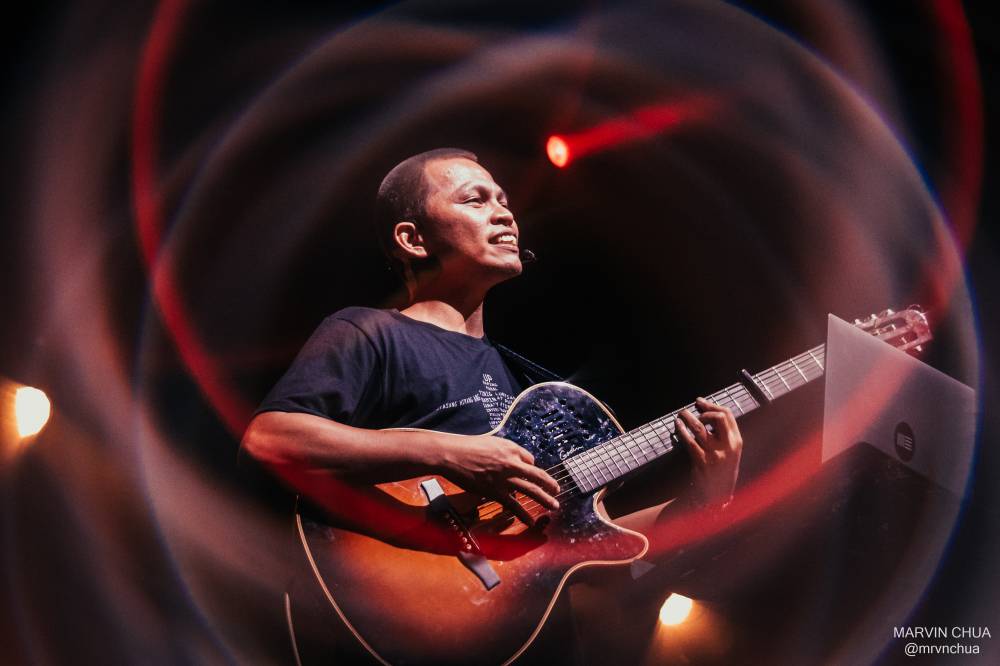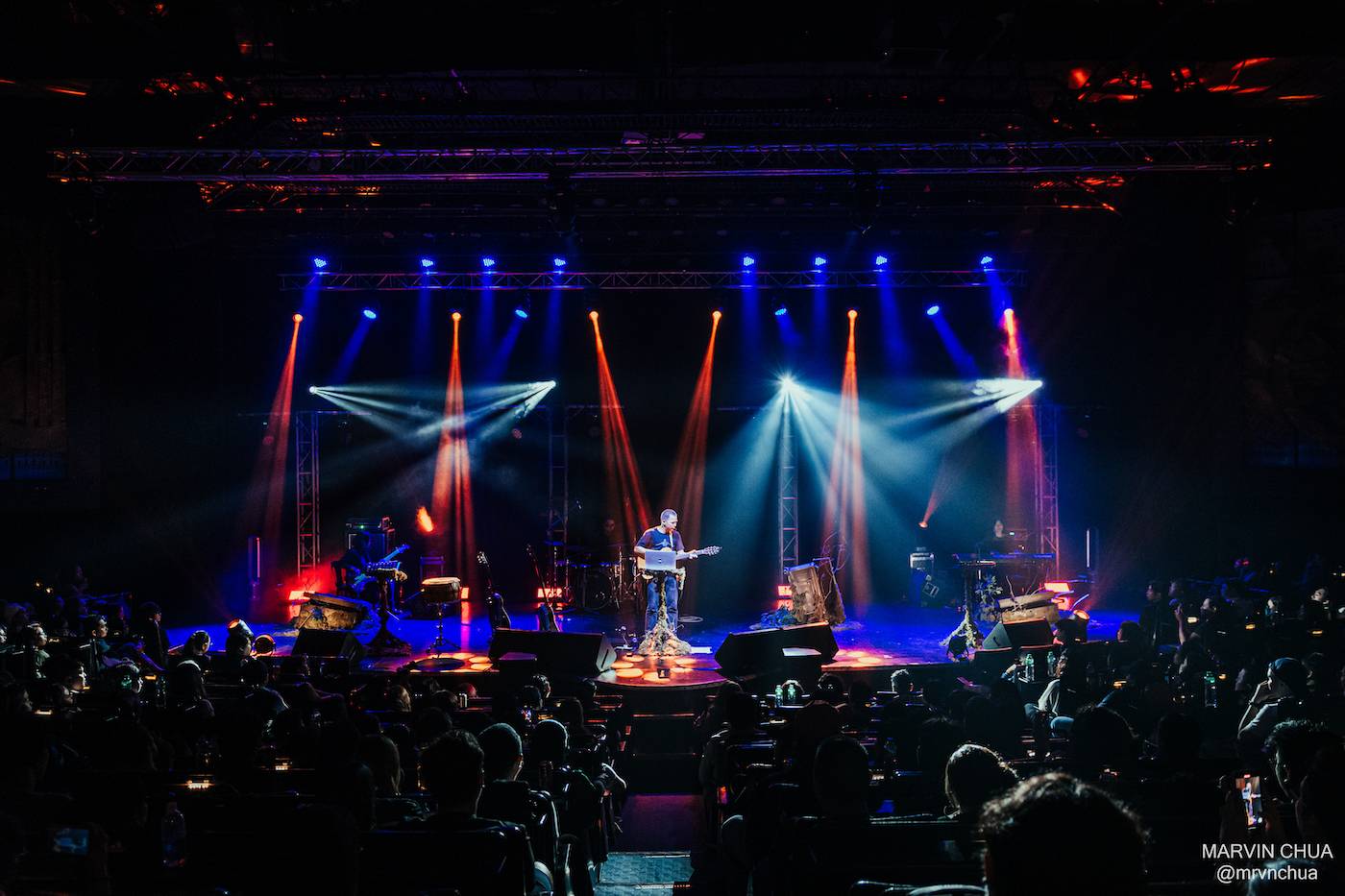Bullet Dumas returns with ‘Nananatili’

In a basic jeans-and-university-T-shirt ensemble, dyed hair shorn close to the scalp, Bullet Dumas cuts an unassuming figure on the vibrantly lit Music Museum stage.
“Medyo cool tayo dito (We’re a little cool here),” he says to his audience: a full house of laidback disciples of good music, noshing on pulutan fare and drinking canned Pale from the lobby snack bar.
“Medyo cool ’to … medyo kulto? (This is kinda cool … this is kinda culty?)” Dumas laughs at his own canny wordplay. Kulto seems about right. For all their coolness, Dumas’ devotees are not a group of people to celebrate their icon’s much-awaited return by half-measures. His Lazarus moment was received with no less than a standing ovation.
On June 8, the artist unveiled “Nananatili” to the public after six years of absence from the stage—as a musician, that is. The show contends with death and the different ways that grief touches those left behind.
“Nananatili,” which premiered brand-new Dumas songs, was produced by Gabi na Naman Productions (GNN), and was cowritten and cocreated by Dumas with Eve Baswel and Flo Reyes. Baswel and Reyes also served as the show’s directors.
‘Great experience’
“Nananatili” struck Dumas’ followers as a bit of a mystery and a surprise as none of the new songs had been released prior to the show. He enjoyed the idea of having people experience his music live for the first time after attending a concert in London where he first got to hear Lianne La Havas.

“It was a great experience, to just be taken by the moment when you experience an artist’s songs for the first time,” he tells Lifestyle in an interview. “Parang astig din na, boog! Eto na ’yung songs (It’s pretty cool to just be like, boog! Here are the songs) … You figure out what to do with them. You like them? Nice. You don’t like them? I can work on them, thank you for the feedback but it’s fine too if you don’t like them.”
Dumas’ last stage outing as a musician was for his album “Usisa” in 2018. In the intervening years, he had taken a stab at acting, performing in the “Ang Huling El Bimbo” musical and even headlining “²Bayani: Isang Rock Opera Alay kay Andres Bonifacio” as the titular hero for his theater debut.
Dumas says his experience in the theater has shaped who he is today. “I’m super thankful for the opportunity. I’ve thought about acting, that it might be something I could do but I never imagined it would be like this, that I would also be pursuing it today because it’s a difficult thing. I’ve also known music all my life, I can just settle with that,” he says.
“Nananatili” is a showcase of Dumas’ evolution as an artist. Followers of his music know him well for his masterful lyrics, prodigious skill on the guitar, raw vocals and highly evocative performances. But the difference between Dumas pre-theater and Dumas post-theater is more than apparent. Where he saw “Usisa” as a vehicle for him to present his music, he took “Nananatili” as an opportunity to tell stories.
GNN invited Dumas October last year to perform a show with his old songs. He, however, had new material he had yet to release and considered the offer as the perfect chance to bring them to the public.
“I didn’t want to do a simple show because I had existing songs which I knew were a little gatmabi (heavy)… I needed to present them in whatever way.”
‘Fractals’
Dumas drew from various resources, bits and bobs of ideas and inspirations he calls “fractals,” to create “Nananatili.” Some of the songs had more or less been “sonically” complete, he says, with the story and lyrics posing more of a challenge to flesh out.
“Mahirap mag-kwento e (It’s hard to tell stories),” he says. “I’ve gone through so many ideas on how to present this whole thing and eventually I just came back to how I tell stories. It’s fun to have it be like you’re just speaking with a friend.”
He credits Baswel and Reyes for helping “police” his mind’s tendency to integrate new fractals and for keeping the story tighter and more contained. The result of this collective effort was a moving narrative revolving around three characters’ unique experiences of loss, which were informed by Dumas’ own.
“Ang dami talagang namatay, ang dami talaga e (There were so many people who died, so many),” he says. “The concept just got triggered in my brain. It came about little by little. Legit, literally it just wrote itself. But I can’t really claim that since it took a great deal of work, but then you know, that’s where it went. I just tried to capture the idea. There was a lot of luck involved.”
While greatly influenced by Dumas’ time doing theater, this pivot to a more experimental approach to performance has not diminished the artist’s grassroots charisma and easy warmth. It has, in fact, revealed more of the scope of his creative prowess.
Dumas makes good on telling three distinct characters’ stories on his own terms, marrying narrative and song with the fresh yet keen instincts of a nascent librettist.
“Nananatili” allowed its audience a glimpse into the sad intimacies and glorious messes of a fractured family bound tenuously together, if only for a moment, by a man who has passed yet whose memory lingers for those who remain—nananatili—to remember him.

Creative growth
Acting had upped the stakes for Dumas, who wanted the show to be an avenue for his friends and mentors in both music and theater to witness his creative growth.
“I don’t wanna f_ck it up … This was a way for me to thank them for helping shape who I am now as an artist,” he says. “I’m happy with the show. Lots of things to improve on, but at least it was fun. There are lots of things to process as well because it’s not just up to me anymore. It’s up for anybody’s interpretation now.”
Some things, however, remain the same. Dumas’ ferocity on his favored instrument is untrammeled. Walking from end to end of the stage barefoot, he required no less than three guitars for the entire performance and one dedicated guy to help him switch them out, not unlike a costume change, as the show’s acts required.
He likened the endeavor of mounting the show to a video game, with its multiple challenges or “bosses.” He considers performance night itself as the ultimate boss. For now, Dumas has nothing in the pipeline and is focused on taking a break after the rigor of the last few months.
“I don’t have anything immediate. I was literally just focused on June 8. The deadline was literally a ‘dead’-line. Welcome to the afterlife, Bullet,” he laughs. “I have to figure out what to do next.”
For those wondering, a digital release of the songs might take some time, unfortunately. Dumas crafted “Nananatili” specifically for the stage and feels the need to rework it for an album format.
An album is just one of the many ideas for different iterations of “Nananatili” knocking around in Dumas’ mind, to be sure. He considers the premiere a “first draft”—but he’s not interested in just sticking to storytelling.
“I can go back to writing singles again. Malaking hinga after nung show (I get to take a big breather after the show) … I really need a break from it, but I realize that it can go so many places.”
For devotees of Dumas’ cult, he has only one thing promised: “Surprise na lang.”
By Eunice Lei Wu

















